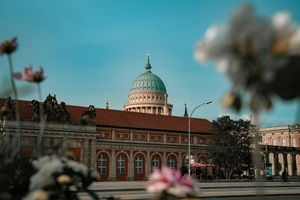
In the organizer's words:
The Filmmuseum Potsdam and Adolf Rosenberger gGmbH present the traveling exhibition HOW TO CATCH A NAZI. Operation Finale: The capture and trial of Adolf Eichmann. The patron of the exhibition in Potsdam is Günther Jauch.
The year 2025 marks the 80th anniversary of the liberation of the Auschwitz concentration camp and the end of the Second World War. With this exhibition, the Filmmuseum Potsdam is taking part in the commemoration of the crimes of the National Socialists. The special educational program and the accessibility of the exhibition are aimed particularly at a young audience: it sends a clear signal for democracy, coming to terms with the past and remembrance.
The exhibition tells the story behind the discovery and capture of Adolf Eichmann in Argentina, one of the main perpetrators of the Holocaust, who was finally tried and convicted in Jerusalem in 1961.
The exhibition HOW TO CATCH A NAZI was developed by the Maltz Museum (USA) in collaboration with a former agent of the Israeli foreign intelligence service and the ANU, the Museum of the Jewish People, and was on display at various locations in the USA from 2016 to 2020. After a historical-scientific revision and expansion of the content, it was shown in Munich from November 2023 to August 2024. Potsdam is the exhibition's second stop in Germany. It will be shown as a special exhibition at the Filmmuseum Potsdam from March 27, 2025 to February 1, 2026. For this purpose, it has been expanded to include a cinematic examination of the Eichmann case and its cultural dimensions of remembrance. The exhibition and the accompanying program inspire questions about which narratives and images shape our media memory.
Short films, 70 photographs and 60 exhibits, including maps and documents, transport visitors directly to the scene at the beginning of the 1960s. They experience the search for Adolf Eichmann from the perspective of the agents of the Israeli foreign intelligence service. The media interest in this case was and is huge. Around 60 feature films and documentaries have been made on the subject in recent decades. In Potsdam, the exhibition will be supplemented by an interactive media station that documents biographical information, the crimes, the capture and the trial in film clips, thus opening up further perspectives.
Adolf Eichmann, the former Obersturmbannführer of the SS at the Reich Security Main Office in Berlin, was largely responsible for the deportation and murder of European Jews. After the war, Eichmann managed to escape to Argentina, where he was able to live for fifteen years under a false identity. The Hessian Attorney General Fritz Bauer, himself a Holocaust survivor, passed on the information about Eichmann's whereabouts to the Israeli authorities in order to ensure that Eichmann was brought to justice in a constitutional trial. As many former National Socialists were still working for the investigating authorities and in public office after the end of the Second World War, he had to assume from his experiences that the perpetrator would even be warned. The exhibition also reflects this and takes a critical look at German society in the post-war period.
The trial against Eichmann in 1961 caused a great international stir: It was the first trial, more than fifteen years after the end of the Second World War, in which large numbers of survivors testified to the crimes of the Nazis before the world public and documented the pain and suffering of the victims. It was only through their testimonies that a deeper and more comprehensive understanding of the Holocaust developed worldwide, also because it was the first trial to be broadcast on television as a new mass medium. This was the only reason why it was able to have such an impact.
Understanding history - shaping the future
Democracy in Germany cannot be taken for granted. This is why teaching young people about the atrocities of the National Socialist regime of injustice is a crucial part of democracy education, especially today. Young people deal with this topic in schools and other educational institutions in particular. It is becoming increasingly difficult for them to find an emotional connection to the crimes of the National Socialist regime of injustice and the people behind it. In order to preserve a living culture of remembrance and prevent the memories of this time from fading, new, innovative and sustainable formats are needed to awaken and appeal to young people.
To this end, the organizers are offering a wide range of educational activities: schoolchildren will guide pupils through the exhibition with a discussion. A cooperation with the Brandenburg Museum aims to connect the exhibition with Jewish life in Brandenburg. Filmernst, an initiative for student and teacher education in Brandenburg, offers a film education program for young people aged 14 and over at the Film Museum.
Remembrance as a reminder
Visitors to the special exhibition are encouraged to take a closer look at the person of Adolf Eichmann and the Holocaust crimes. The exhibition also highlights the need to prosecute these crimes after 1945 and to bring justice to the victims. Particularly against the backdrop of social tensions, the exhibition reminds us of the high values of democracy and the rule of law that are worth protecting. It appeals to visitors to make a commitment to democracy education in their own everyday lives.
A broad program of events consisting of films, lectures and discussions invites visitors to explore the topic in depth from different perspectives.
















